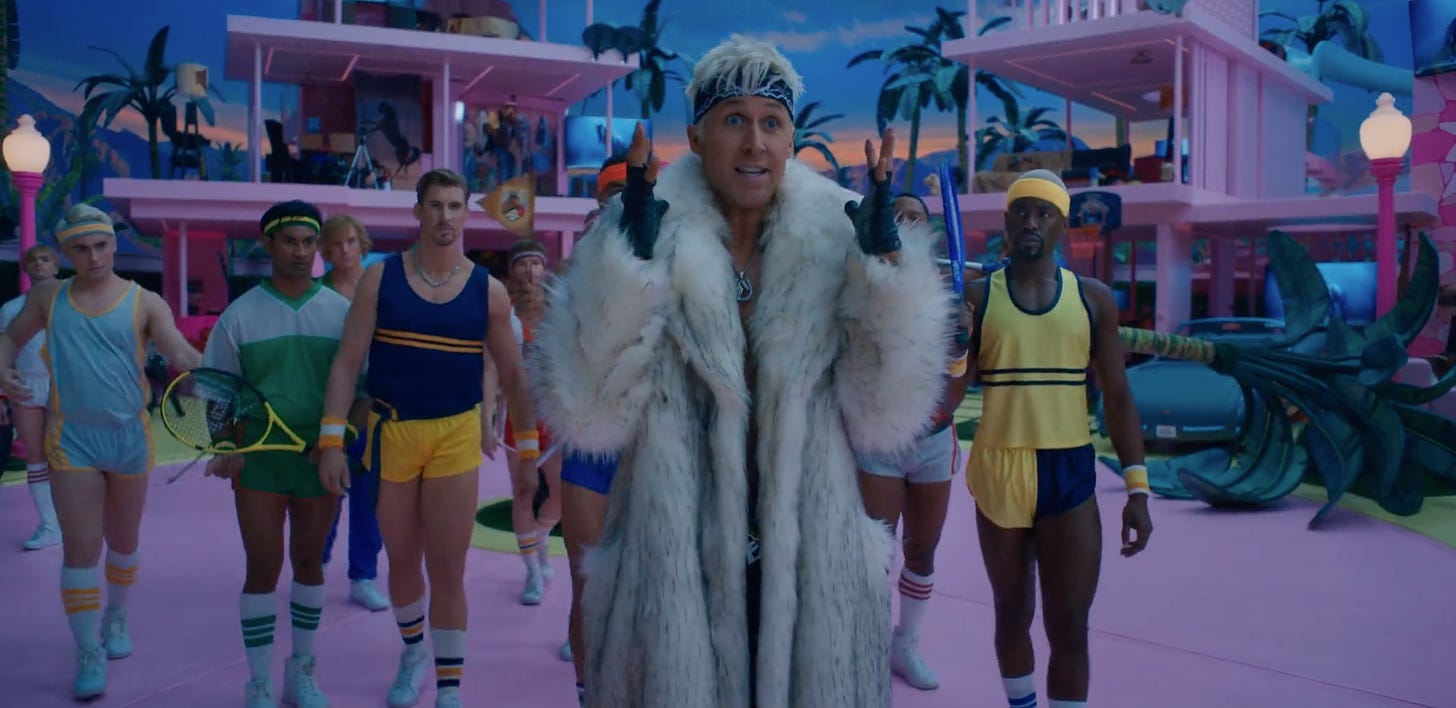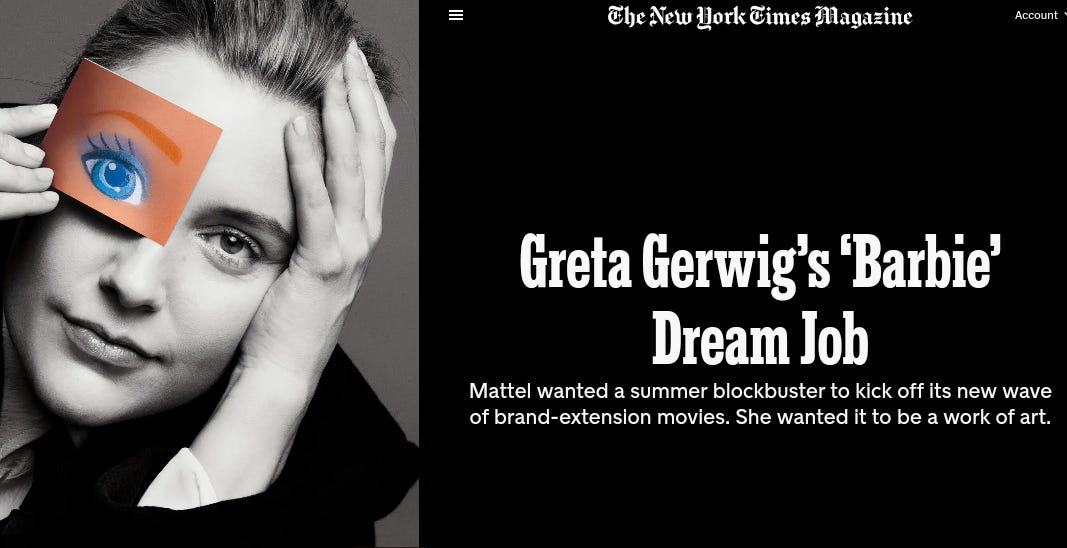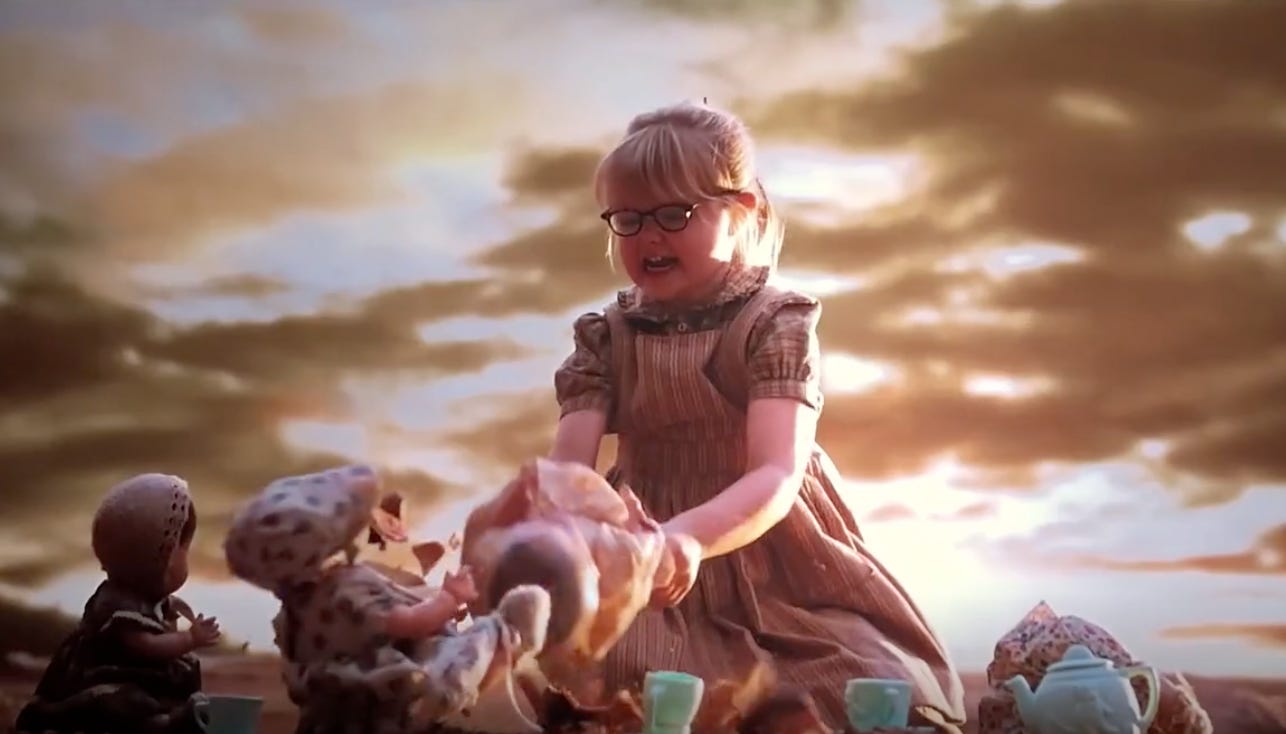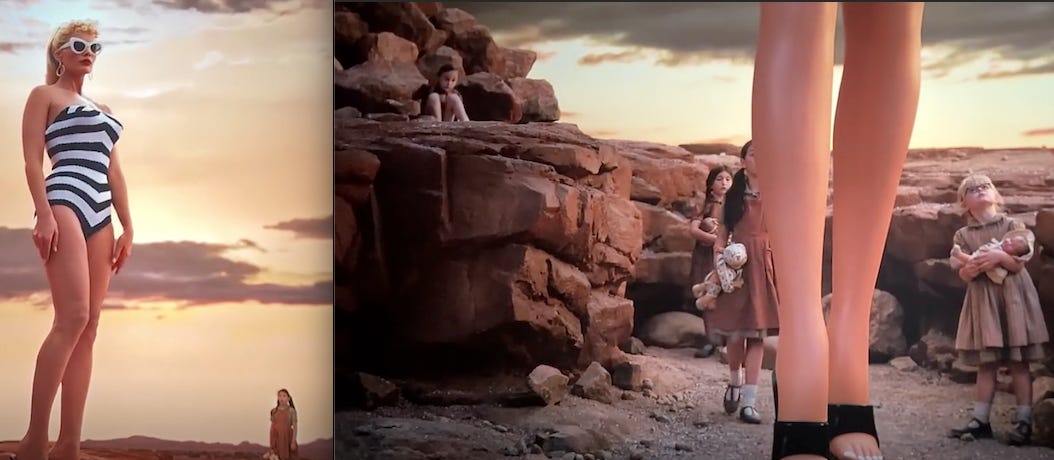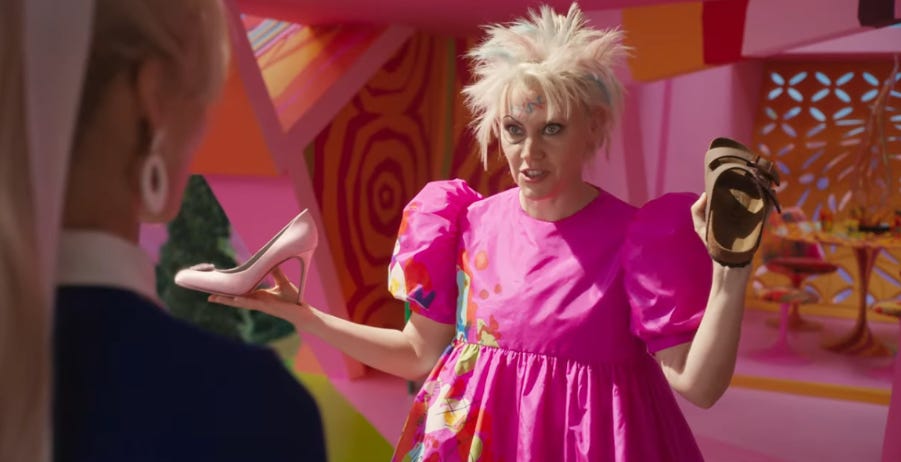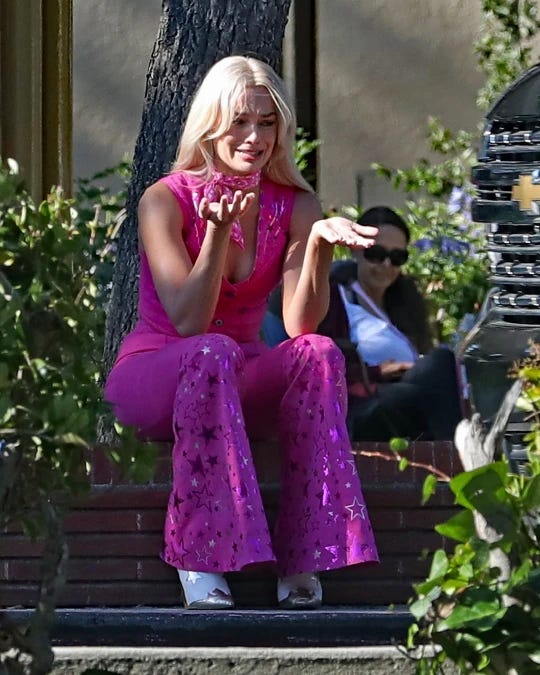Barbie: Doing the Thing and Subverting the Thing
Listen to an audio reading of this article:
The new Barbie movie hit the theatres July 21, and it is already grossing over $330 million, surpassing Oppenheimer and the Sound of Freedom by a wide margin.
First off, Barbie is an American movie, made by Americans, intended for an American audience. The Barbie Doll is a children’s toy manufactured by the American toy company Mattel and launched in 1959, created by American businesswoman Ruth Handler.
Barbie the doll is also a product (literally) of American consumer culture. Barbie has a beautiful Dreamhouse with rooms for furniture and accessories. Barbie is single with no kids and drives her own car. Kids can expand the Barbie-verse by buying more clothes and accessories. She is a material girl living in a material Barbie world.
And like all things American, Barbie the Movie, is politically and culturally charged. A quick Twitter search brings up Ben Shapiro’s scathing review of the movie. After setting fire to Barbie and Ken dolls, Shapiro launches into a 43-minute full frontal assault.
No, really, he set fire to Barbie and Ken. Seems sacrilegious somehow, partly because Barbie is an American cultural icon, and secondly, because they are children’s toys.
NBC News claimed that “The internet is roasting Ben Shapiro for hate-watching Barbie—while dressed like Ken.”
It’s hard not to agree that Shapiro was hate-watching, after his opening salvo: “This movie is not just a piece of shit. It’s a flaming piece of dog shit piled atop a dumpster fire, piled atop a landfill, filled with dog shit. It is one of the worst movies I’ve ever seen. On every possible level, it is a horrific movie.”
Don’t hold back, Ben.
He does concede it has “nice production values.”
Matt Walsh, filmmaker of the documentary What is a Woman?, called it a “preachy feminist screed about taking down the patriarchy.”
Jack Posobiec, another conservative commentator called Barbie a “man-hating Woke propaganda fest.”
From the Woke side of the fence:
Adding woke fuel to the fire, lesbian critic Kayla Kumari Upadhyaya, claims that, “Straightness in Barbieland is cringe … Barbie makes a farce of heterosexuality” and the movie “exposes heterosexuality in general as a wholly goofy enterprise.”
When did heterosexuality become the enemy?
Christy Lemire, who writes for RogerEbert.com could barely contain herself, gushing that, “Barbie is a dazzling achievement, both technically and in tone. It’s a visual feast that succeeds as both a gleeful escape and a battle cry. So crammed with impeccable attention to detail is Barbie that you couldn’t possibly catch it all in a single sitting.”
CBC journalist, Jenna Benchetrit, was a trifle more even-handed, dwelling on the underlying social commentary: “The Barbie doll carries more weight in the cultural consciousness than she can bear on her famously disproportionate frame. She's at once a symbol of feminine aspiration, the careerist everywoman who in 1962 owned a home before most real women could have credit cards—and she is also, as a teenage character in the newly released Barbie movie puts it, “a professional bimbo,” “a symbol of sexualized capitalism,” “a glorification of rampant consumerism,” and “a fascist.”
Cultural Subversion
The New York Times article on the subject, complete with an interview of director Greta Gerwig, reads like a thesis for a post-modern literature course:
“The movie is a celebration of Barbie and a subterranean apologia for Barbie. It is a giant corporate undertaking and a strange, funny personal project. It is a jubilant, mercilessly effective polymer-and-pink extravaganza whose guiding star turns out to be Gerwig’s own sincerity.”
Despite the obvious, that Barbie is a kid’s movie with toys as the central characters, the New York Times treats Greta Gerwig as an artistic savant. Gerwig herself assumes the role of spiritual guru: “I really thought of it like a spiritual journey.”
Gerwig says she is “Doing the thing and subverting the thing.” The Times author considers the subversive thing is to take “an immense, divisive toy brand and bend it to the heartfelt and counterintuitive purpose of making women feel good.”
Cultural subversion according to the Times and Gerwig means that Barbie lives in a world that has “the comfort of fundamentalism,” because there is no death, aging or shame, and “you never have to wonder what you’re meant to do.”
The Amazonian Barbies rule Barbieland in a Utopian matriarchy. There is a President Barbie in Barbieland, and the Ken beta-males frolic at the beach in a gender role reversal. Like Batman’s sidekick Robin, Ken has no separate existence without Barbie.
Ryan Gosling, who plays Ken looks like he borrowed his wardrobe from Ben Stiller in the movie Zoolander and then hired the Village People for his backup band.
And then, for my more conspiracy minded readers, the New York Times article includes the obligatory one-eyed photo. Hmmm, wonder what that means?
The movie seems to be an exhaustive attempt to squeeze every cultural drop out of Barbie’s 70-year history as girl-toy, role model, anti-girl and feminist icon.
The opening scene is the giveaway of the intent of the entire pink flick. In a parody of 2001: A Space Odyssey, young girls dressed like Amish kids are dutifully tending baby dolls, until a giant Barbie shows up mimicking the monolith from Kubrick’s film. The Amish kids get instant enlightenment and smash their dolls to pieces.
The subtext of the film is that religion subjugated women to a life of drudgery, making babies and homemaking. The liberated superwoman, represented by Barbie, is savvy, sexy, single and flush with cash. “She has her own money, her own house, her own car, her own career,” the narrator intones. “Because Barbie can be anything, woman can be anything.”
Now that we’ve dealt with all the deep, dark issues, I have a public confession to make. I actually enjoyed the movie! Ok, shocker I know. Lock me in the woke prison, but on a surface level as a fun movie for kids, especially girls who can go with their moms, it was a wonderfully campy, kitschy flick. I also loved Toy Story and went to see it with my adult male pals who loved it too.
The movie is filmed in splendiferous pink, the humour and music are light and refreshing. The premise of the movie is clever, and gives adults who are buying the tickets and taking their kids, something to think about.
It does, however, make for many layers of social commentary. The perfect matriarchal Utopia of Barbieland is fake and artificial, and Barbie is an airhead. Barbie has a wake up call when she has to go to the real world after her feet suddenly go flat and she finds cellulite on her leg. Barbie is offered a choice, like in the Matrix of taking the red pill or the blue pill, and going to the real world. In this case, it’s the High Heel or the Birkenstock:
Beta-male Ken follows Barbie to the real world and has an epiphany, when he encounters patriarchy. He becomes empowered and gets his male mojo going, exclaiming jubilantly to Barbie, “Men rule the world!”
Barbie finds her owner, a teenager named Sasha, who grew bored of playing with dolls years before. She finds Sasha at high school surrounded by her friends, who are all dressed in dark, drab baggy clothing—in sharp contrast to Barbie’s neon pink cowgirl costume. Instead of a welcome greeting, thanking Barbie for being girls’ favourite toy, Sasha gives Barbie a dressing down:
“You’ve been making women feel bad about themselves since you were invented. You represent everything wrong with our culture—sexualizing capitalism. You set the feminist movement back years. You destroy girls’ innate sense of worth and you’re destroying the Earth with your glorification of rampant consumerism. Until you showed up here and declared yourself Barbie I hadn’t thought about you in years, you fascist!”
Barbie breaks down and has an existential crisis. Oh cold, cruel world!
Meanwhile, Ken goes off on a testosterone rampage, having spent some time in the school library learning about patriarchy. He soon gets a rude awakening upon discovering he can’t get a job anywhere in the real world, because he doesn’t have any education or skills.
“Being a man isn’t enough?” he asks innocently.
Undaunted, Ken goes back to Barbieland to do some mansplaining about patriarchy to the rest of the Kens. He launches a coup, overthrowing the matriarchy while drinking brewskis. and getting foot massages by the Barbies. And there’s still an hour left in the movie. Wow.
At this point, if you are expecting this to be nice love story where Ken gets the Barbie girl, loses the Barbie girl and gets the Barbie girl back, prepare for some disappointment. The movie is a let down in some ways. Barbie and Ken forging their own destinies, without each other, does not evoke the warm fuzzies. It’s more like an amiable divorce where the partners agree to face the harsh realities of life alone.
For the Ben Shapiros and other hate-watchers, it should be noted that we will never go back to the world of a hundred years ago when women were second-class citizens, fighting for the right to vote. Although, the movie begins with a direct assault on motherhood, it has the consolation prize of opening up a discussion on what it means to be male and female in a modern world. Even though the Barbie movie’s not so subtle theme that “matriarchy is surely better than patriarchy“ is flawed, it does offer food for thought within the subversion.
Follow us on Facebook, Twitter, Instagram, Rumble, Bitchute, TikTok, or YouTube. If you want to read more, you can buy one of Rick Thomas’ books. New paid subscribers will receive a free copy of FreePolitik.
FreePolitik: Geopolitics in the Context of the World Wide Freedom Movement
How to Defeat the New World Order
The best way to keep up to date with what we’re doing is subscribe to the mailing list at VictoryCanada.today which will get you an email notification for our social activism, and on Substack, whenever we post another article.
All works are narrated by MB Bose. Thank you for your continued support and encouragement.







